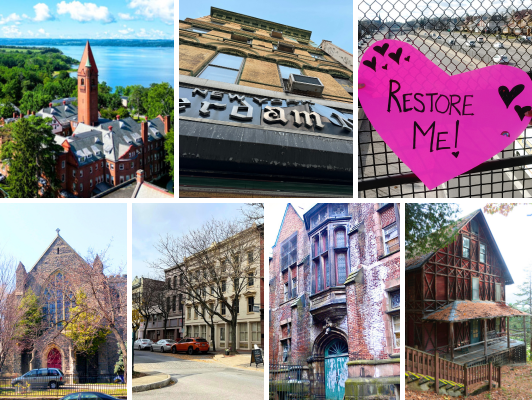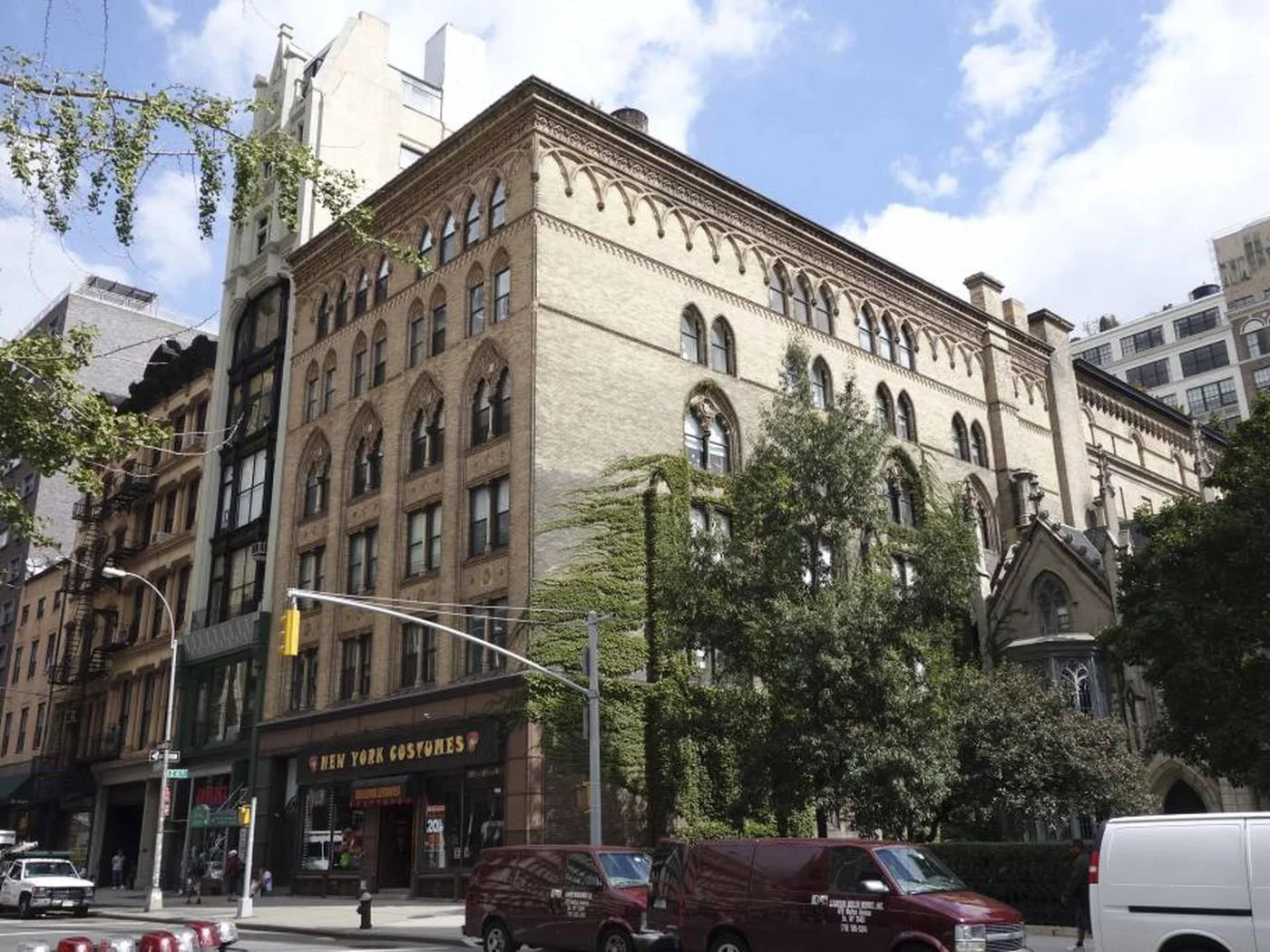The Preservation League of NYS is thrilled to announce its biennial listing of the most at-risk historic sites around the state. The 2025-2026 Seven to Save list includes buildings and landscapes, represents communities both urban and rural, and showcases many eras of our state’s history. The listings themselves are both singular and representative — illustrating pervasive issues impacting not just these sites, but sites like them across the state and beyond.
Read MoreBy the time some historic places end up on the Seven to Save list they have suffered from years of vacancy and/or significant disrepair. Our final theme in this year's anniversary retrospective will highlight three such listings that have since gone on to have incredible transformations: the former Eastman Dental Dispensary in Rochester, the former TWA Flight Center in Queens, and Bent’s Opera House in Medina.
Read MoreMain Streets serve as the physical, economic, and cultural center of a community, home to municipal offices, banks, local businesses, and community gathering spaces. They can be one block long or ten (or more!); rural, suburban, or urban; with simple single story wood frame buildings or high style multi-story masonry buildings, and everything in between. Over the past 25 years, many Main Streets across the state have landed on our Seven to Save list – from Downtown State Street in Schenectady back in 2000 to the listing of Downtown Oneonta’s Historic District just last year.
Read MoreBy our count, almost 20 neighborhoods have been included as Seven to Saves over the years – not counting Main Streets! Two threats tend to loom largest over Seven to Save communities: development pressure and deterioration. Gentrification, rising housing costs, and overdevelopment can push longtime residents out of their homes. Systemic disinvestment and lack of resources can make it difficult for residents to take care of their historic homes. Tools like historic district designation, Homeowner historic tax credits, and a push for affordable housing in historic neighborhoods helps to build sustainable communities. Neighborhood groups, local preservation and community-based organizations, and neighborhood residents (whether they be homeowners or renters) are the driving forces in preserving these kinds of sustainable communities.
Read MoreIn many ways, New York is defined by its relationship to water. New York City and Long Island are surrounded by it. The Hudson River shoots north all the way into the Adirondacks. The Finger Lakes are home to picturesque landscapes and thriving communities. Lakes Ontario and Erie form our western border. And of course, the Erie Canal is the reason New York is called the Empire State. Our coastal, river-, lake-, and canal-side communities are rich in history. But being on the water can also put historic structures at risk – from natural erosion and increased flooding caused by climate change to development pressure caused by increased real estate value.
Read MoreWith shifts in population, budget constraints, and older buildings no longer meeting contemporary needs, many educational buildings have been vacated and left to deteriorate without an immediate new use on the horizon. In some cases, the buildings are so large that finding a new use proves difficult. In others, districts outgrow their historic buildings and move on. Regardless of particular circumstances, educational buildings tend to be local landmarks, deeply connected to a community’s identity and sense of place. People often have a strong emotional connection to these places because they used them as a children, or members of their families did. Losing these places can be a major blow to a community.
Read MoreWaterways, roadways, railways, and airports – the architecture of how we get around can tell us a lot about the time in which it was constructed and how our communities have evolved and developed over the years. Whether purely utilitarian in its original conception or a grand statement of forward-looking aspirations, many great buildings and structures have fallen out of use and landed on our Seven to Save list. But just because something can no longer be used for its original purpose doesn’t mean it can’t still be useful.
Read MoreWhen highlighting underrepresented histories through a Seven to Save listing, it is key for the League to bolster the work already being done by local advocates. It is not necessarily our job to come in and declare a place important — local communities are able to decide that for themselves. Rather, the League can play an important role supporting and advocating alongside the people with roots in these places.
Read MoreSince we first began drawing attention to at-risk places with a Seven to Save designation, some places have been lost, some are still endangered, and others have gone on to be remarkable success stories. There are lessons to be learned in all three cases. For our anniversary year, we wanted to look at the program with a thematic retrospective – highlighting seven themes we’ve seen pop up in our listings over the past 25 years. Over the course of the year, we’ll be digging into our STS archive to highlight places across the state that help tell a broader story of preservation in New York. In this post we are teasing the themes we’re going to be looking at more deeply later in the year. We hope you’ll follow along!
Read MorePart of the League’s 2023 Seven to Save artist commissions, this pair of carvings by Fitzhugh Karol was inspired by the roofline of James Brooks’ studio. Together, these two carved cedars, cut from the forest in Springs, are representative of the collaborative creative life of James Brooks and Charlotte Park.
Read MoreHistoric preservation can serve as an economic life raft for upstate cities like Oneonta, but the public perception of preservation can be a challenge. As a way to celebrate the historic district, the League commissioned local artist Emily Falco to create a site-specific sidewalk mural strategically located in front of the Greater Oneonta Historical Society.
Read MoreThe Preservation League was saddened to learn of the loss of the former Kenwood Convent, also known as the former Academy of the Sacred Heart, in Albany. In 2010, shortly after the building was vacated, the League listed the building on our Seven to Save list; our colleagues at the Historic Albany Foundation likewise included it on their Endangered Historic Resources List. This beautiful campus was rich in both history and frustrations: architecturally distinctive, historically fascinating, but subject to a series of failed development projects in recent years. The site was left vacant and vulnerable for over a decade. On March 23, despite the valiant efforts of first responders, it was lost to a terrible fire. Thumbnail image: Jim Franco for the Times Union
Read MoreOn Monday, August 15, the NYS Office of Parks, Recreation & Historic Preservation (OPRHP) issued an official determination that the former Willard State Hospital complex is eligible for the State and National Registers of Historic Places. The Finger Lakes campus, which straddles the town lines of Ovid and Romulus, is one of the League’s 2022-2023 Seven to Save sites.
Read MoreThe proposed Pennsylvania Station Civic and Land Use Project (the "Penn Area Plan") would demolish multiple blocks of historic buildings in New York City in the vicinity of Pennsylvania Station while displacing thousands of residents and businesses. The devastating plan put forward by New York State's Empire State Development Corporation is an eerie echo of the loss of the original Pennsylvania Station, coming as it does 60 years after the famous 1962 sidewalk picket by the Action Group for Better Architecture in New York (AGBANY), which included Jane Jacobs and a host of notable architects and preservationists fighting to prevent the demise of that great train station.
Read MoreThe neighborhood South of Union Square holds a unique place in the history of women’s rights and women’s suffrage movements. In the very same University Place building where a prominent 19th-century philanthropist donated to women’s causes, a famed lesbian bar attracted trailblazing women writers. In two buildings on Fifth Avenue, numerous progressive organizations were founded and blossomed: the first organization to insure contraception, the first African American magazine, and a chapter of the oldest women’s peace organization — the latter two under female leadership. On East 14th Street, the headquarters of the New York City Woman Suffrage League led the organizing effort for achieving women’s suffrage in New York State; and back on University Place the first woman doctor in America established her home and office.
Read MoreThe 2022-2023 inclusion of the Proposed South of Union Square Historic District on the League’s Seven to Save list marks the third time the League has worked with our colleagues at Village Preservation through the STS program. First in 2002 with the Gansevoort Market District and then in 2012 with South Village, the League’s support helped turn the tide for both in securing their much-deserved landmark designations.
Read MoreJames Renwick, Jr. (November 1, 1818 — June 23, 1895) was one of the 19th century’s most prolific and successful American architects. Renwick is best known for his mastery of the Gothic Revival and Romanesque styles, as evidenced in his masterworks Grace Church (1843-1858), St. Patrick’s Cathedral on Fifth Avenue (1859-1878), and the Smithsonian Institute on Washington D.C.’s Mall (1846). James Renwick, Jr.’s New York roots are in the area south of Union Square. Descended from the Brevoort family who held a great deal of land in the neighborhood, it is no surprise that Renwick left his mark on the built environment of this neighborhood.
Read MoreBeautifully detailed 1899 “Mail & Express” Broadway Streetscape Illustrations demonstrate the urgency of Village Preservation’s campaign to landmark the area #SouthOfUnionSquare.
Read MoreJames Brooks and Charlotte Park’s Home and Studios in East Hampton has been included on the 2022-2023 Seven to Save list. The Brooks-Park site belonged to Abstract Expressionist painters James Brooks and Charlotte Park who were foundational members of the AbEx Art movement. The site has been vacant since 2010 and has fallen into significant disrepair. A group of grassroots advocates have sprung up to fight to save this important historic site and the natural landscape on which it sits. The League is eager to assist this efforts and bring much-deserved attention to the artists who made this place their home.
Read MoreWillard State Hospital is one of this year’s Seven to Save. Situated on Seneca Lake in the Finger Lakes village of Romulus, Willard State has been a key part of the community since it first opened as a psychiatric hospital in the late 1800s. It began a second life as a correctional facility in 1995, but the complex has just recently been completely abandoned. The League is eager to work with local stakeholders to stabilize the buildings and grounds and explore potential new uses for this sprawling historic complex.
Read More



















